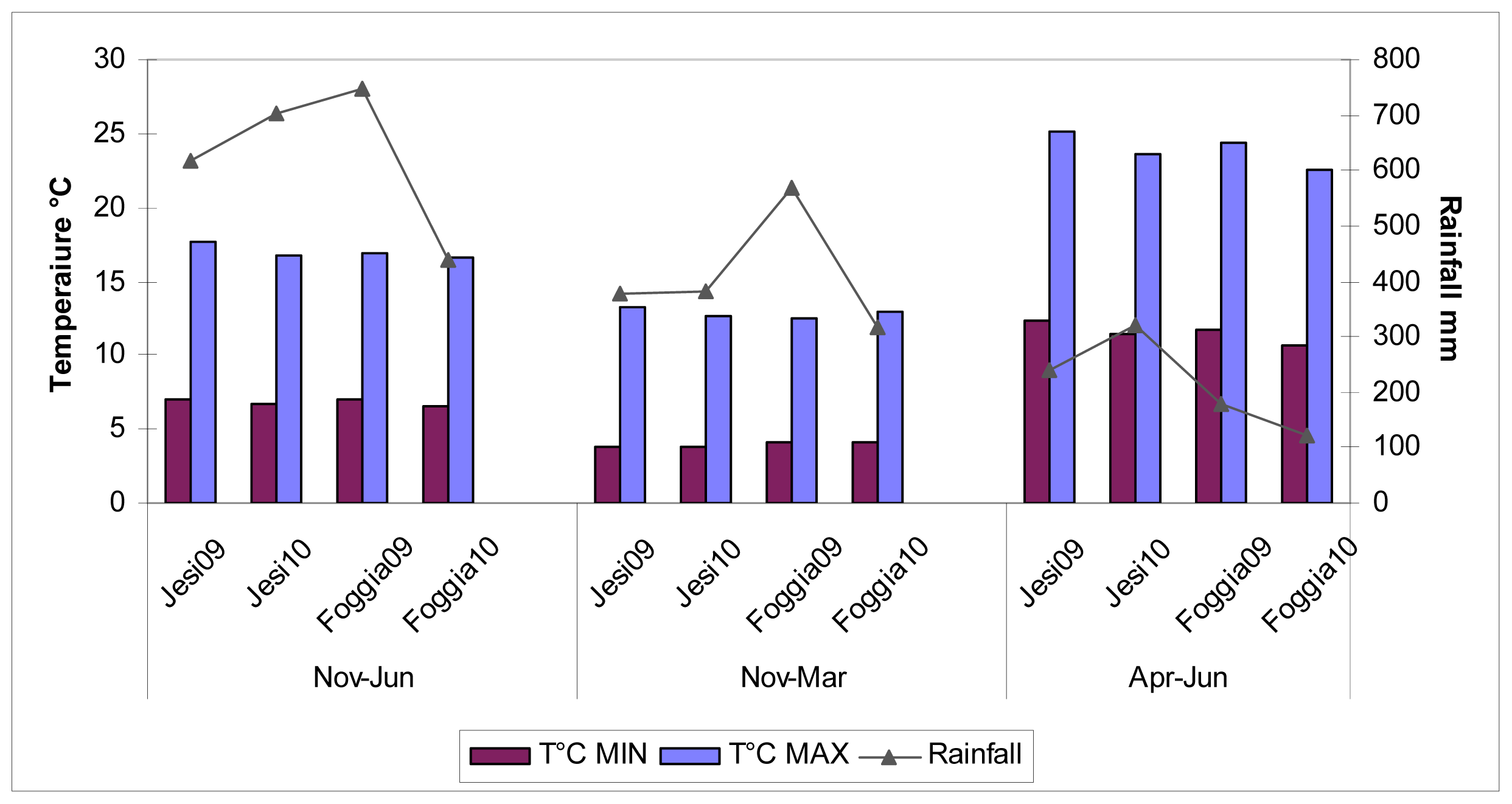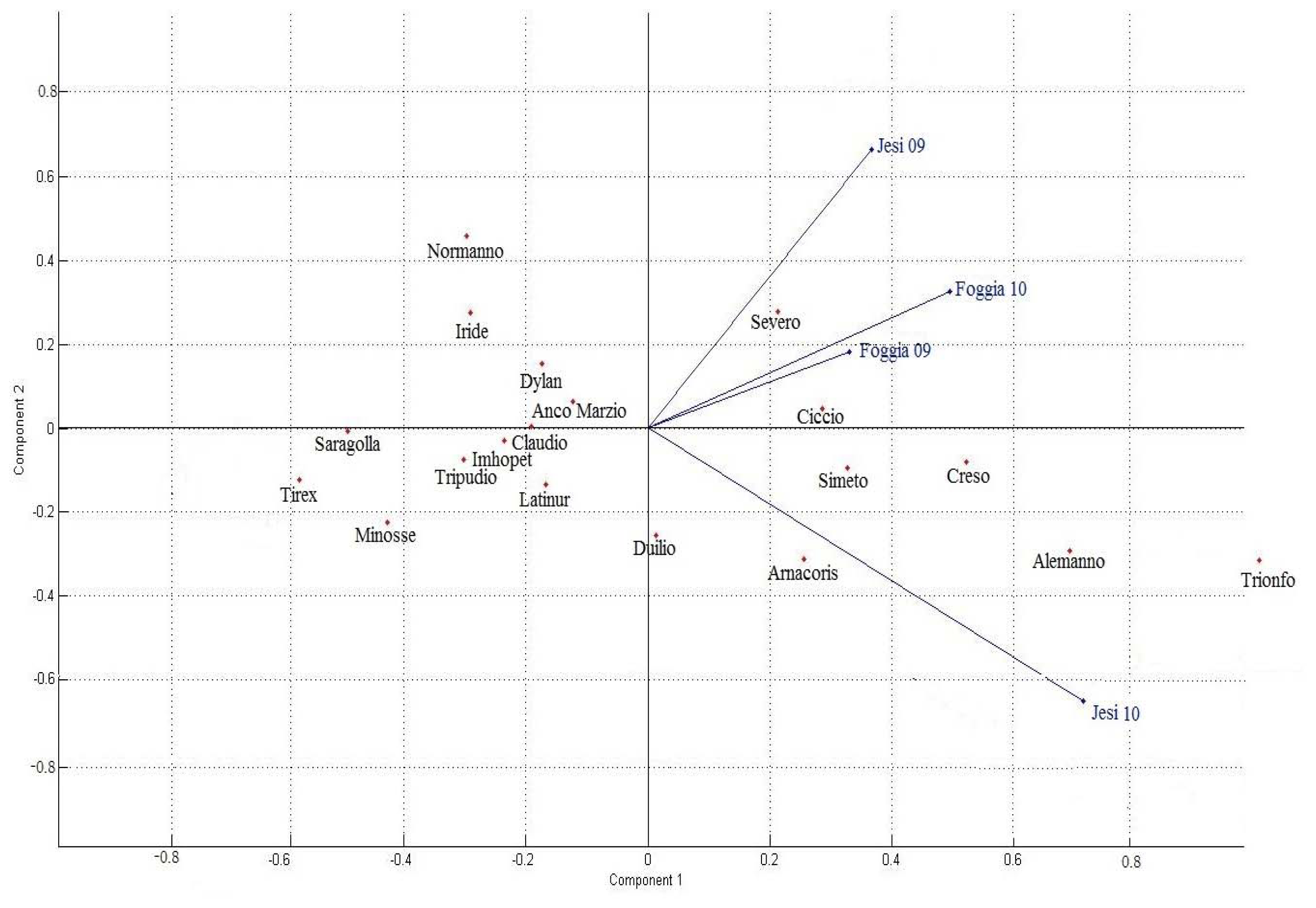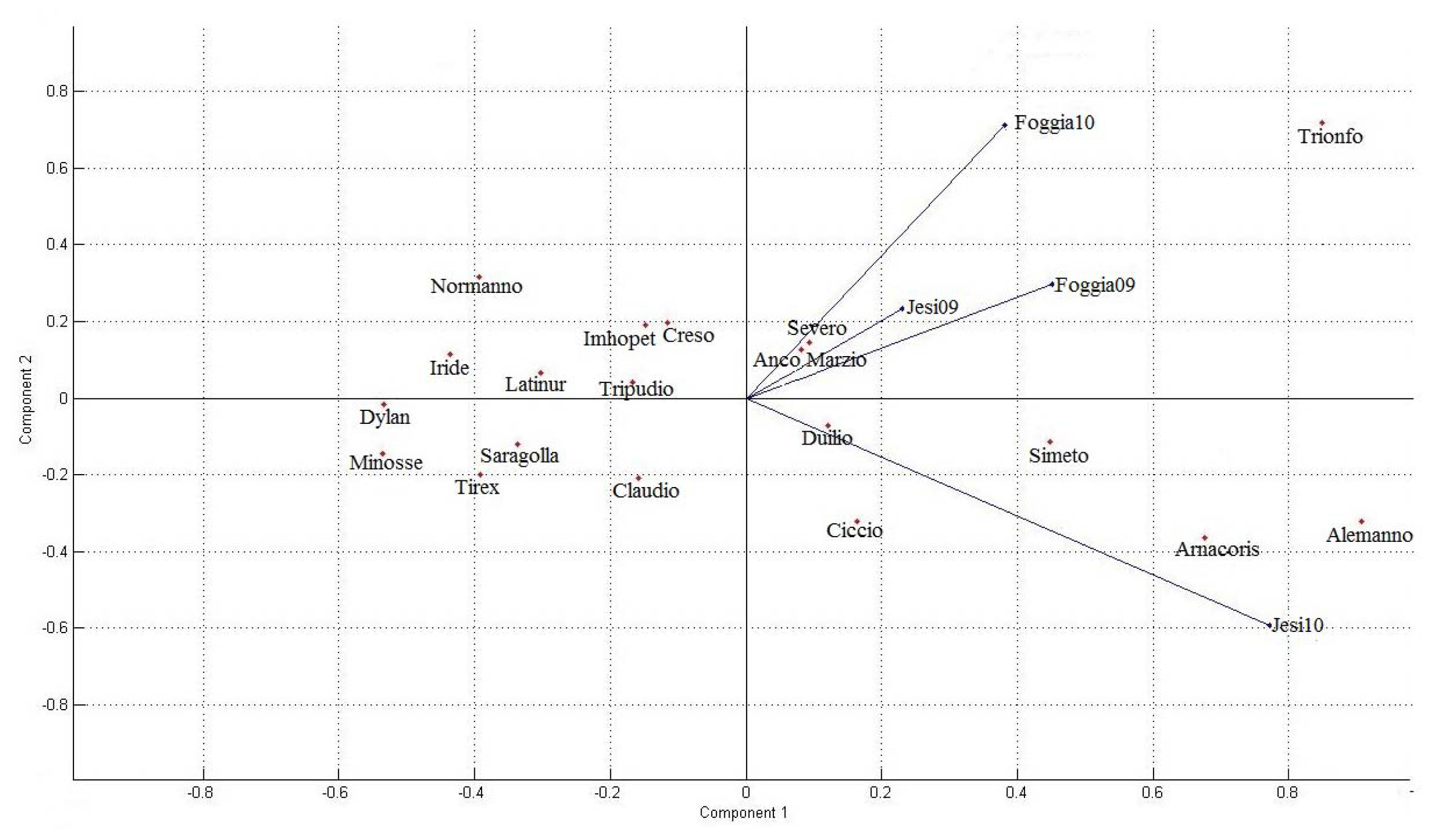Variations in Content and Extractability of Durum Wheat (Triticum turgidum L. var durum) Arabinoxylans Associated with Genetic and Environmental Factors
Abstract
:1. Introduction
2. Results and Discussion
2.1. Grain Characteristics and Relationships among Grain Traits
2.2. ANOVA
2.3. Varietal Variability for AX Fractions
2.4. AX Fraction Variability in Monosaccharide Composition
2.5. Principal Component Analysis (PCA)
3. Experimental Section
3.1. Durum Wheat whole Grain Samples
3.2. Environment Description
3.3. Grain Characteristics
3.4. Chemical Analyses
3.5. Statistical Analysis
4. Conclusions
Acknowledgements
References
- Ward, JL; Poutanen, K; Gebruers, K; Piironen, V; Lampi, AM; Nystrom, L; Andersson, AAM; Aman, P; Boros, D; Rakszegi, M; et al. The HEALTHGRAIN cereal diversity screen: concept, results, and prospects. J. Agric. Food Chem 2008, 56, 9699–9709. [Google Scholar]
- Saura-Calixto, F; Perez-Jimenez, J; Goni, I. Contribution of cereals to dietary fibre and antioxidant intakes: toward more reliable methodology. J. Cereal Sci 2009, 50, 291–294. [Google Scholar]
- Liu, RH. Whole grain phytochemicals and health. J. Cereal Sci 2007, 46, 207–219. [Google Scholar]
- Shewry, PR. The HEALTHGRAIN programme opens new opportunities for improving wheat for nutrition and health. Nutr. Bull 2009, 34, 225–231. [Google Scholar]
- Jones, JM; Engleson, J. Whole grains: Benefits and challenges. Annu. Rev. Food Sci. Technol 2010, 1, 19–40. [Google Scholar]
- Slavin, J. Why whole grains are protective: biological mechanisms. Proc. Nutr. Soc 2003, 62, 129–134. [Google Scholar]
- Camire, ME. Technological challenges of whole grains. Cereal Food World 2004, 49, 20–22. [Google Scholar]
- American Dietetic Association. Position of the American Dietetic Association: Health implications of dietary fiber. J. Am. Diet. Assoc 2008, 108, 1716–1731.
- Viuda-Martos, M; López-Marcos, MC; Fernández-López, J; Sendra, E; López-Vargas, JH; Pérez-Álvarez, JA. Role of fiber in cardiovascular diseases: A review. Compr. Rev. Food Sci. Food Saf 2010, 9, 240–258. [Google Scholar]
- Gemen, R; de Vries, JF; Slavin, JL. Relationship between molecular structure of cereal dietary fiber and health effects: focus on glucose/insulin response and gut health. Nutr. Rev 2011, 69, 22–33. [Google Scholar]
- Tungland, BC; Meyer, D. Nondigestible oligo-and polysaccharides (dietary fiber): Their physiology and role in human health and food. Compr. Rev. Food Sci. Food Saf 2002, 3, 90–109. [Google Scholar]
- Slavin, JL; Jacobs, D; Marquart, L; Wiener, K. The role of whole grain in disease prevention. J. Am. Diet. Assoc 2001, 101, 780–785. [Google Scholar]
- Mares, DJ; Stone, BA. Studies on wheat endosperm. I. Chemical composition and ultrastructure of the cell walls. Aust. J. Biol. Sci 1973, 2, 793–812. [Google Scholar]
- Saulnier, L; Sado, PE; Branlard, G; Charmet, G; Guillon, F. Wheat arabinoxylans: exploiting variation in amount and composition to develop enhanced varieties. J. Cereal Sci 2007, 46, 261–281. [Google Scholar]
- Andersson, R; Aman, P. Advanced Dietary Fibre Technology; McCleary, BV, Prosky, L, Eds.; Blackwell Science: Oxford, UK, 2001; pp. 301–314. [Google Scholar]
- Courtin, CM; Delcour, JA. Physicochemical and bread-making properties of low molecular weight wheat-derived arabinoxylans. J. Agric. Food Chem 1998, 46, 4066–4073. [Google Scholar]
- Courtin, CM; Delcour, JA. Arabinoxylans and endoxylanases in wheat flour bread-making. J. Cereal Sci 2002, 35, 225–243. [Google Scholar]
- Garcia, A; Otto, B; Reich, SC; Weickert, MO; Steiniger, J; Machowetz, A; Rudovich, NN; Katz, N; Speth, M; Meuser, F; et al. Arabinoxylan consumption decreases postprandial serum glucose, serum insulin and plasma total ghrelin response in subjects with impaired glucose tolerance. Eur. J. Clin. Nutr 2007, 61, 334–341. [Google Scholar]
- Saulnier, L; Peneau, N; Thibault, JF. Variability in grain extract viscosity and water soluble arabinoxylan content in wheat. J. Cereal Sci 1995, 22, 259–264. [Google Scholar]
- Ordaz-Ortiz, JJ; Saulnier, L. Structural variability of arabinoxylans from wheat flour. Comparison of water-extractable and xylanase-extractable arabinoxylans. J. Cereal Sci 2005, 42, 119–125. [Google Scholar]
- Hong, BH; Rubenthaler, GL; Allan, RE. Wheat pentosans. I. Cultivar variation and relationship to kernel hardness. Cereal Chem 1989, 66, 369–373. [Google Scholar]
- Li, S; Morris, CF; Bettge, AD. Genotype and environment variation for arabinoxylan in hard winter and spring wheats of the U.S. Pacific Northwest. Cereal Chem 2009, 86, 88–95. [Google Scholar]
- Finnie, SM; Bettge, AD; Morris, CF. Influence of cultivar and environment on water-soluble and water-insoluble arabinoxylans in soft wheat. Cereal Chem 2006, 83, 617–623. [Google Scholar]
- Lempereur, I; Rouan, X; Abecassis, J. Genetic and agronomic variation in arabinoxylan and ferulic acid contents of durum wheat (Triticum durum L.) grain and its milling fractions. J. Cereal Sci 1997, 25, 103–110. [Google Scholar]
- Gebruers, K; Dornez, E; Boros, D; Fras, A; Dynkowska, W; Bedo, Z; Rakszegi, M; Delcour, JA; Courtin, CM. Variation in the content of dietary fiber and components thereof in wheats in the HEALTHGRAIN diversity screen. J. Agric. Food Chem 2008, 56, 9740–9749. [Google Scholar]
- Turner, MA; Soh, CHN; Ganguli, NK; Sissons, MJ. A survey of water-extractable arabinopolymers in bread and durum wheat and the effect of water-extractable arabinoxylan on durum dough rheology and spaghetti cooking quality. J. Sci. Food Agric 2008, 88, 2551–2555. [Google Scholar]
- D’Egidio, MG; Mariani, BM; Nardi, S; Novaro, P; Cubadda, R. Chemical and technological variables and their relationships. Suitability in evaluation of textural characteristics of cooked pasta. Cereal Chem 1990, 70, 67–72. [Google Scholar]
- Sissons, M. Role of durum wheat composition on the quality of the pasta and bread. Food 2008, 2, 75–90. [Google Scholar]
- Sgrulletta, D; Scalfati, G; De Stefanis, E; Conciatori, A. Dietary fibre components of high-fibre commercial products. Effect of cooking process. Ital J Food Sci 2005, XIII, 285–294. [Google Scholar]
- Bettge, AD; Morris, CF. Relationships among grain hardness, pentosan fractions and end-use quality of wheat. Cereal Chem 2000, 77, 241–247. [Google Scholar]
- Gebruers, K; Dornez, E; Bed, Z; Rakszeg, M; Fras, A; Boros, D; Courtin, CM; Delcour, JA. Environment and genotype effects on the content of dietary fiber and ist components in wheat in the HEALTHGRAIN diversity screen. J. Agric. Food Chem 2010, 58, 9353–9361. [Google Scholar]
- Dornez, E; Gebruers, K; Joye, IJ; De Ketelaere, B; Lenartz, J; Massaux, C; Bodson, B; Delcour, JA; Courtin, CM. Effects of genotype, harvest year and genotype-by-harvest year interactions on arabinoxylan, endoxylanase activity and endoxylanase inhibitor levels in wheat kernels. J. Cereal Sci 2008, 47, 180–189. [Google Scholar]
- Andersson, R; Westerlund, E; Tilly, AC; Aman, P. Natural variation in the chemical composition of white flour. J. Cereal Sci 1993, 17, 183–189. [Google Scholar]
- Coles, GD; Hartunian-Sowa, SM; Jamieson, PD; Hay, AJ; Atwell, WA; Fulcher, RG. Environmentally-Induced variation in starch and non-starch polysaccharide content in wheat. J. Cereal Sci 1997, 26, 47–54. [Google Scholar]
- Martinant, JP; Billot, A; Bouguennec, A; Charmet, G; Saulnier, L; Branlard, G. Genetic and environmental variations in water-extractable arabinoxylans content and flour extract viscosity. J. Cereal Sci 1999, 30, 45–48. [Google Scholar]
- Barron, C; Surget, A; Rouau, X. Relative amounts of tissues in mature wheat (Triticum aestivum L.) grain and their carbohydrate and phenolic composition. J. Cereal Sci 2007, 45, 88–96. [Google Scholar]
- AACC, Approved Methods of the American Association of Cereal Chemists; American Association of Cereal Chemists: Saint Paul, MN, USA, 1995.
- Lai, VMF; Shin, L; Heisien, HW; Haan, CH. Non-starch polysaccharide compositions of rice grains with respect to rice variety and degree of milling. Food Chem 2007, 101, 1205–1210. [Google Scholar]
- Association of Official Analytical Chemists (AOAC), Official Methods of Analysis, 16th ed; Cunniff, P (Ed.) AOAC: Gaithersburg, MD, USA, 1995.
- Albersheim, P; Nevins, DJ; English, PD; Kan, A. A method for the analysis of sugars in plant cell-wall polysaccharides by gas liquid chromatography. Carbohydr. Res 1967, 5, 340–345. [Google Scholar]
- Englyst, HN; Quigley, ME; Hudson, GJ. Determination of dietary fibre as non-starch polysaccharides with gas-liquid chromatographic, high-performance liquid chromatographic or spectrophotometric measurement of constituent sugars. Analyst 1994, 119, 1497–1509. [Google Scholar]
- Ingelbrecht, JA; Verwimp, T; Grobet, PJ; Delcour, JA. Behaviour of Triticum durum Desf. Arabinoxylans and arabinogalactan peptides during industrial pasta processing. J. Agric. Food Chem 2000, 48, 2017–2022. [Google Scholar]




| Quality Traits | Environments | |||
|---|---|---|---|---|
| Foggia09 | Foggia10 | Jesi09 | Jesi10 | |
| Grain weight (g) | 44.7 ± 4.1 | 43.6 ± 3.3 | 47.2 ± 5.8 | 46.7 ± 3.6 |
| Grain diameter (mm) | 2.7 ± 0.1 | 2.7 ± 0.1 | 2.8 ± 0.3 | 2.8 ± 0.1 |
| Grain Hardness index | 82.7 ± 4.6 | 88.0 ± 5.1 | 88.7 ± 3.7 | 86.8 ± 3.6 |
| Protein content | 12.1 ± 0.82 | 12.11 ± 0.64 | 16.2 ± 0.79 | 14.7 ± 1.46 |
| TOAX content | 4.7 ± 0.33 | 4.6 ± 0,27 | 4.5 ± 0.31 | 4.8 ± 0.41 |
| WUAX content | 4.0 ± 0.29 | 4.0 ± 0.31 | 3.9 ± 0.29 | 4.2 ± 0.44 |
| WEAX content | 0.7 ± 0.31 | 0.6 ± 0.17 | 0.6 ± 0.23 | 0.6 ± 0.29 |
| D.F. | Arabinoxylan Fractions | |||
|---|---|---|---|---|
| Source of Variation | TOAX | WUAX | WEAX | |
| Varieties (A) | 18 | 749.07 *** | 994.84 *** | 94.82 *** |
| Error | 18 | 0.001 | 0.001 | 0.001 |
| Environments (B) | 3 | 781.96 *** | 530.05 *** | 120.11 *** |
| A × B | 54 | 73.42 *** | 77.24 *** | 83.51 *** |
| Error | 57 | 0.001 | 0.002 | 0.001 |
| Arabinoxylan Fractions | |||
|---|---|---|---|
| Varieties | TOAX | WUAX | WEAX |
| Normanno | 4.6 ± 0.27 g | 3.8 ± 0.21 j | 0.7 ± 0.34 cd |
| Trionfo | 5.2 ± 0.30 a | 4.6 ± 0.43 a | 0.6 ± 0.32 gh |
| Iride | 4.6 ± 0.21 ghi | 3.8 ± 0.13 kl | 0.8 ± 0.13 bc |
| Tirex | 4.3 ± 0.17 m | 3.7 ± 0.35 m | 0.6 ± 0.34 hi |
| Anco Marzio | 4.6 ± 0.21 ghi | 4.1 ± 0.12 e | 0.5 ± 0.10 jk |
| Simeto | 4.8 ± 0.38 d | 4.2 ± 0.47 d | 0.7 ± 0.19 ef |
| Severo | 4.8 ± 0.20 d | 4.1 ± 0.06 e | 0.7 ± 0.22 de |
| Creso | 4.9 ± 0.34 c | 4.0 ± 0.08 gh | 0.9 ± 0.38 a |
| Claudio | 4.5 ± 0.20 j | 3.9 ± 0.22 j | 0.6 ± 0.22 fg |
| Ciccio | 4.8 ± 0.23 d | 4.0 ± 0.36 fg | 0.8 ± 0.19 b |
| Alemanno | 5.0 ± 0.52 b | 4.5 ± 0.50 b | 0.5 ± 0.12 ij |
| Arnacoris | 4.7 ± 0.41 e | 4.3 ± 0.55 c | 0.5 ± 0.19 k |
| Saragolla | 4.4 ± 0.10 | l 3.9 ± 0.14jk | 0.6 ± 0.17 ij |
| Tripudio | 4.4 ± 0.16 k | 3.9 ± 0.04 hi | 0.5 ± 0.14 jk |
| Imhopet | 4.5 ± 0.18 ij | 3.9 ± 0.27 i | 0.6 ± 0.23 fgh |
| Latinur | 4.5 ± 0.23 ghij | 3.8 ± 0.16 j | 0.7 ± 0.18de |
| Duilio | 4.6 ± 0.35 f | 4.1 ± 0.18 ef | 0.6 ± 0.19 hi |
| Minosse | 4.4 ± 0.26 | l 3.7 ± 0.19 m | 0.7 ± 0.31 de |
| Dylan | 4.5 ± 0.14 hij | 3.8 ± 0.17 l | 0.8 ± 0.12 bc |
| average | 4.6 ± 0.23 | 4.0 ± 0.24 | 0.7 ± 0.12 |
| lsd p ≤ 0.01 | 0.046 | 0.046 | 0.046 |
© 2011 by the authors; licensee MDPI, Basel, Switzerland. This article is an open-access article distributed under the terms and conditions of the Creative Commons Attribution license (http://creativecommons.org/licenses/by/3.0/).
Share and Cite
Ciccoritti, R.; Scalfati, G.; Cammerata, A.; Sgrulletta, D. Variations in Content and Extractability of Durum Wheat (Triticum turgidum L. var durum) Arabinoxylans Associated with Genetic and Environmental Factors . Int. J. Mol. Sci. 2011, 12, 4536-4549. https://doi.org/10.3390/ijms12074536
Ciccoritti R, Scalfati G, Cammerata A, Sgrulletta D. Variations in Content and Extractability of Durum Wheat (Triticum turgidum L. var durum) Arabinoxylans Associated with Genetic and Environmental Factors . International Journal of Molecular Sciences. 2011; 12(7):4536-4549. https://doi.org/10.3390/ijms12074536
Chicago/Turabian StyleCiccoritti, Roberto, Giulia Scalfati, Alessandro Cammerata, and Daniela Sgrulletta. 2011. " Variations in Content and Extractability of Durum Wheat (Triticum turgidum L. var durum) Arabinoxylans Associated with Genetic and Environmental Factors " International Journal of Molecular Sciences 12, no. 7: 4536-4549. https://doi.org/10.3390/ijms12074536




